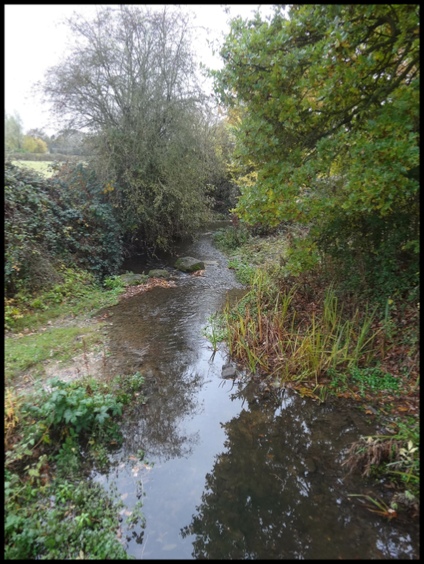
UP THE RODING
An occasional blog about walking in the edgelands of North East London and various other places
There is no comments capability on this blog, but you can send me an email at blog@holli.co.uk
WALKING THE RIVER RODING FROM THAMES TO SOURCE
Leg 8: The Roding Villages
21 November 2016
This leg of my walk took me past the Rodings, the nine villages or hamlets that bear the name of the river: Abbess Roding, Aythorpe Roding, Beauchamp Roding, Berners Roding, High Roding, Leaden Roding, Margaret Roding, Morell Roding, and White Roding. Although it meanders between them, the river does not actually pass through any of the villages - the nearest I came to them was when the footpath brought me out onto a short stretch of the road through Aythorpe Roding.
Upstream from Shellow Bridge, where I ended the previous section of the walk, the river passes through Birds Green Fishery. It was a rather cool and cloudy day, but there were still a few enthusiasts huddled underneath their umbrellas and tents by the side of the lakes.

One of the Birds Green fishing lakes

The River Roding at Birds Green
Beyond Birds Green, the Roding flows by the side of a large embankment which encloses a much larger lake, several hundred feet across. This is unnamed on the map, but is in fact an agricultural reservoir that has been recently converted into yet another fishing lake, where you can pay for the pleasure of spending an entire day attempting to catch a 30 pound carp and then putting it back into the water.

The countryside beyond the lakes has plenty of rights-of-way that enabled me to track the course of the river as they zig-zagged back and forth. Passing along the edge of the fields I noticed a number of metal seats attached to the trees - these puzzled me at first, until I disturbed a couple of large birds hiding in the grass, and realized that the seats were for the shooting of the pheasant.

These seats are for shooting at …

… these birds. I spotted this pheasant wandering around one of the church graveyards that I passed during the walk.
After skirting around a couple of field edges, I entered a meadow which contained this odd-looking structure - all by itself in the otherwise empty field. I presumed it was for local festivities of some sort … but not on this cold November morning.

On the far side of the field I discovered the Roding flowing along in a straight, man-made channel - another example of how the river has been canalised, diverted, and generally messed about:

Further on, as I passed through ploughed fields, there was little to see except sky and earth …

Situated in the borderland between the sky above and earth below are the numerous churches that are dotted around the landscape, their towers and steeples piercing the horizon. These country churches are especially noticeable in Essex since they are often isolated from the villages that they serve - either because the church originally belonged to the lord of the manor or because the place of settlement has shifted over the centuries. One such example is the 13th century manor church of Aythorpe Roding, which lies about half-a-mile or so from the village:

Up upon the ridge where the village of Aythorpe Roding is now located, I could see a large windmill. This is apparently once again in working order after restoration work, although its blades were stationary when I passed by.

After some 10 miles of walking around the field edges, and sometimes having to cross ploughed farmland, the clay soil of Essex was sticking to my boots and my feet felt as if they each weighed several pounds extra. Eventually, I reached the village of Great Canfield and called it a day. Just one more section of the walk, and I should reach the source of the river …

The River Roding, approaching Great Canfield























